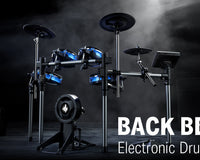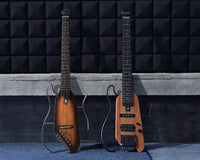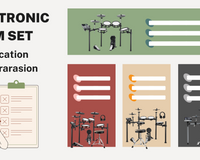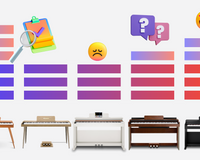For beginners, learning to play the ukulele is a friendly start. Generally speaking, the ukulele is more affordable than most other instruments. It is also small in size, and you can learn and practice anywhere and in any situation. Besides, the nylon strings on the ukulele are also friendlier to beginners’ fingers with no callus than the acoustic guitar. Finally, having fewer frets than acoustic guitars makes it easier for beginners to get a grip on the ukulele.
However, choosing a ukulele for beginners can be tricky. So, in this ukulele buying guide, we will walk you through the important information that you may need when choosing your ukulele.
Table of Contents
How Many Types Of Ukulele Are There?
The biggest reason why choosing ukuleles is complicated is that there are various types of them and some of them even have names in Latin. Variations are also provided in the same type. So, the next part informs you of various kinds of ukulele and their differences.
|
Type |
Scale Length |
Full Length |
|
Soprano |
13’’ |
21’’ |
|
Concert |
15’’ |
23’’ |
|
Tenor |
17’’ |
26’’ |
|
Baritone |
19’’ |
30’’ |
Specs of Different Ukulele Types
Soprano
The first ukulele ever created is a soprano type. It is the smallest of the ukulele family and is also the most common ukulele associated with people’s impressions. The soprano incorporates a 13" scale length (the length of the vibrating strings) and a 21" full length. It offers sweet and bright sounds we usually hear from a ukulele. As the frets are closer together, Donner soprano ukuleles are great if the beginner has smaller hands.
Concert
The bigger brother in the ukulele family is the concert model. It features a 15’’ scale length and 23’’ full length. With a longer scale, the concert produces louder sounds with lower frequencies. However, because the differences in scale are tiny, the sounds of the soprano and concert are similar.

Tenor
With a 17’’ scale length and a 26’’ overall length, the tenor ukulele offers more resonant, ringing, and sustaining sounds than the two smaller ukuleles. A longer scale means there is more room for each fret and between stings. Players with bigger hands may find it better to fret on the tenor.
Baritone
As the biggest member of the ukulele family, the baritone features the deepest bass frequencies and is capable of producing the loudest sounds in the family with a 19'' scale length and a 30'' scale length. Its body length and fretboard scale make it the most playable one for players with big hands. Unlike the other 3 types of ukuleles, the baritone is different in tuning. The four strings of the baritone are tuned in G3-D3-B3-E4 starting from the lowest strings. It is the exact same tuning as the highest four strings on the guitar so it is easiest to learn for guitar players.
Acoustic-Electric Ukulele
Same on the acoustic guitar, manufacturers managed to integrate electronics into the ukulele. An acoustic-electric ukulele normally incorporates a built-in pickup which allows vibrations of the strings to be transformed into signals that can be exported to amplifiers and sound interfaces through the preamp that is normally placed in the one side of the ukulele. Since the nylon strings on the ukulele do not generate relatively loud sounds like the steel strings on the acoustic guitar, an amplifier or interface would be significant if you plan to perform live in a slightly bigger venue or an open space. Normally, the built-in preamp of a ukulele features sound control and tone control for adjustment. Some also include a tuner in the preamp. You can also get an EQ control on the Donner acoustic-electric ukulele.

Donner-Electric-23-inch-Concert-Ukulele
What Else Affects the Tones of the Ukulele?
Shape
Generally speaking, there are two types of ukuleles. Although the shape does not affect the tones as much as the tonewood, it is worth mentioning for the subtlety.
Guitar Shape: The guitar shape is the most common and standard shape of the ukulele. Some people call it the gourd shape because its upper body is smaller than the lower part. The guitar-shaped ukulele features a beautiful curve in the waist of the instrument, and cutaways on the upper body are also provided on the ukulele for more accessible higher frets and solo playing.

Donner DUC400 21-inch Guitar Shape Ukulele
Pineapple Shape: The pineapple shape ukulele is designed with a rounder and less curved body than the guitar shape. Its design language speaks in Hawaiian as shown in its body shape and decorations. The rounder body of the pineapple gives it a slightly warmer and more resonant sound. But it is hard to tell a big difference between these two shapes.

Tone Wood
Like most other acoustic string instruments, the tonewoods of the ukulele are significant in the instrument's acoustic characteristics. However, a good musical instrument is not made by placing all the components on a piece of raw wood. The wood only contributes to a part of the excellence. The craft and the unity of all the components are also important. Good tonewoods are very important, but the craft is also key.
Laminated and Solid Wood
Like what happens with the acoustic guitar, laminated wood and solid wood should be your first concerns when choosing a ukulele. When the concept of laminated and solid wood is mentioned, it refers to the body material of the instrument. Solid wood means the body is made of a single type of tonewood, while laminated wood means the body is made of several layers of wood that are glued together with grained veneer on the top to make the body look natural. Although these two types of wood may look alike, the tones are what set them apart. Generally speaking, solid wood features a better resonance for its unity.Nevertheless, the solid wood that boasts excellence in tones also has its disadvantages. The stability and hardness of the solid wood are what have been disturbing the gear heads for years. In special climates where the temperature and humidity can change drastically in a day, solid wood becomes vulnerable, thus cracking and deforming can easily happen. Even if you have to pay extra attention and do frequent maintenance on a more costly solid wood ukulele, the extra money you pay for it can be an investment. Solid wood instruments like guitars, ukuleles, pianos, and so on tend to produce mellower, warmer, and richer sounds as they age. It is like tasting a new bottle of grape wine that you can never finish, and then you have the rich and juicy taste of an old bottle years later.
Types of Tone Woods
Hawaiian Koa
The most widely recognized material for Ukulele is the rare Hawaiian hardwood species Koa, known as the Hawaiian Koa tree, which features light brown in color and beautiful grain. It has a gentle sound similar to mahogany, but Koa has a higher density than mahogany. The tone is brighter and the low frequencies are weaker. Koa’s tone is more focused on medium frequency. The high frequency is smooth and compressed, and the low frequency is clear but weak.
Mahogany
Mahogany is a commonly seen tonewood type grown in various regions of the world. It features beautiful grain and is usually used as the material for guitar and ukulele bodies and necks. Generally, although mahogany has numerous varieties and they are a little different in details, it tends to generate warm and rich tones with rich mid and low frequencies. If you like ukuleles made from mahogany, the Donner Soprano Mahogany Ukulele could be a good choice.
Maple
Maple is another commonly seen material for guitars. It features a bright look, high density, and hardness. Due to its stability and not being prone to deform, maple is used for nearly the wooden parts on the guitar. The grain on the maple is beautiful and maple with the flame-like grain is usually used for the top of a guitar body. Because of its hardness, it is usually used for the fretboard or bridge on the ukulele.
Rosewood
With high density, the rosewood is commonly seen on the fretboards of string instruments. On the ukulele, rosewood is commonly used for the fretboard and body. With the growing rarity of rosewood, manufacturers start to use Pau Ferro as the substitute for rosewood. So, you may also see the use of Pau Ferro on ukuleles.
Spruce
Spruce is a popular kind of tonewood used in guitars. With the growing demands in ukulele, manufacturers begin to adopt spruce in ukulele. Spruce features white or beige. Its color is clean and neat and the grain is straight. The tone of it is crisp and bright.
Cedar
Although softer than spruce, cedar is still a kind of hardwood. The tones it offers are mellow and full so it is often used on tenor and baritone which feature heavier sounds.
In summary, ukuleles are different in types, sizes, and shapes, and these features directly affect the tones and playability of the ukulele. As with what happens on guitars, the body woods are to be carefully considered if you want your future ukulele to sound as you expect.
If you've already decided what kind of ukulele to buy, then we'll pick the right accessories last. Buying accessories one by one can be time-consuming, and you have to wait for them to arrive and pay extra. So buying them in a ukulele bundle is a reasonable choice.
Which Ukulele Accessories Do I Need?
A digital tuner is highly recommended because of the ukulele's special tunings. You may also want to buy a ukulele gig bag considering the ukulele's mobility, which is convenient for you to have on the road for practice or fun playing. A strap may also be needed as holding your ukulele while standing can be tiring and affect your playing. As your playing time gets longer, you will need consumables like picks and strings.
Luckily, Donner offers every one of these items in the ukulele bundles. Besides the instrument, a Donner digital tuner, a pack of picks, a quality gig bag, a strap, and a set of quality nylon stings are included in the all-in-one bundle, which can save you a lot of time as a beginner. Be sure to check them out if you are interested.









































2 comments
Kristen Sample
Beginner comparison shopping
Thank you this was an excellent article. My dad played ukulele when I was a child. He’s passed on & so did his uke. I’m retired and would like to learn & carry on the tradition. This article will be helpful to make my decision. I’ve looked at Flight ukuleles too. Thanks again for the article.
Kosmically yours,
Kristen Sample
Douglas Crosby
Special Thanks for being Awesome DONNER10 :-) I wanted to share the idea of being able to play music this Christmas 2021 & y’all gave me that opportunity thru your great deals and I wanted to say thank you!! I was especially fond of a larger platform & nice wood work, but still manageable. The DONNER 26" Tenor is really special, fitting all of my expectations easily! This DONNER Tenor you’ve made sounds wonderful & looks fantastic! I really appreciate what you’ve done here!!
Best Regards,
Doug Crosby
Orlando, FL.